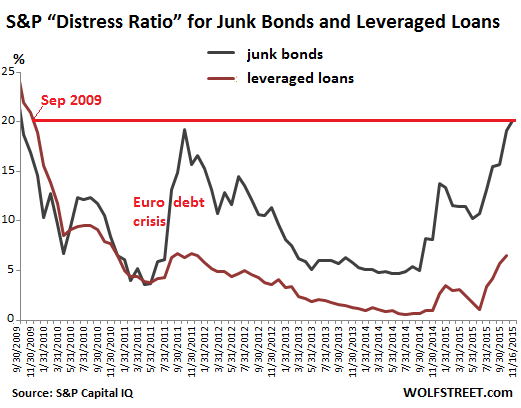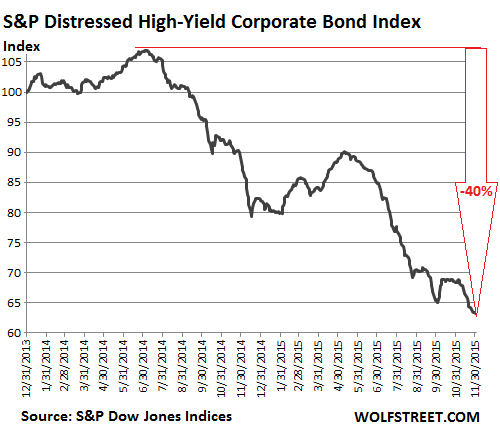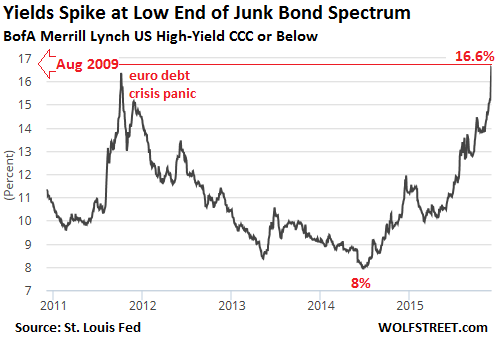Investors bloodied as the Credit Bubble implodes at the bottom
Investors, lured into the $1.8-trillion US junk-bond minefield by the Fed’s siren call to be fleeced by Wall Street and Corporate America, are now getting bloodied as these bonds are plunging.
Standard & Poor’s “distress ratio” for bonds, which started rising a year ago, reached 20.1% by the end of November, up from 19.1% in October. It was its worst level since September 2009.
It engulfed 228 companies at the end of November, with $180 billion of distressed debt, up from 225 companies in October with $166 billion of distressed debt, S&P Capital IQ reported.
Bonds are “distressed” when prices have dropped so low that yields are 1,000 basis points (10 percentage points) above Treasury yields. The “distress ratio” is the number of non-defaulted distressed junk-bond issues divided by the total number of junk-bond issues. Once bonds take the next step and default, they’re pulled out of the “distress ratio” and added to the “default rate.”
During the Financial Crisis, the distress ratio fluctuated between 14.6% and, as the report put it, a “staggering” 70%. So this can still get a lot worse.
The distress ratio of leveraged loans, defined as the percentage of performing loans trading below 80 cents on the dollar, has jumped to 6.6% in November, up from 5.7% in October, the highest since the panic of the euro debt crisis in November 2011.
The distress ratio, according to S&P Capital IQ, “indicates the level of risk the market has priced into the bonds. A rising distress ratio reflects an increased need for capital and is typically a precursor to more defaults when accompanied by a severe, sustained market disruption.”
And the default rate, which lags the distress ratio by about eight to nine months – it was 1.4% in July, 2014 – has been rising relentlessly. It hit 2.5% in September, 2.7% in October, and 2.8% on November 30.
This chart shows the deterioration in the S&P distress ratio for junk bonds (black line) and leveraged loans (brown line). Note the spike during the euro debt-crisis panic in late 2011:
The oil-and-gas sector accounted for 37% of the total distressed debt and sported the second-highest sector distress ratio of 50.4%. That is, half of the oil-and-gas junk debt trades at distressed levels! The biggest names are Chesapeake Energy with $7.4 billion in distressed debt and Linn Energy LLC with nearly $6 billion.
Both show how credit ratings are slow to catch up with reality. S&P still rates Chesapeake B- and Linn B+. Only 24% of distressed issuers are in the rating category of CCC to C. The rest are B- or higher, waiting in line for the downgrade as the noose tightens on them.
The metals, mining, and steel sector has the second largest number of distressed issues and sports the highest sector distress ratio (72.4%), with nearly three-quarters of the sector’s junk debt trading at distressed levels. Among the biggest names are Peabody Energy with $4.7 billion in distressed debt and US Steel with $2.2 billion.
These top two sectors account for 53% of the total distressed debt. And now there are “spillover effects” to the broader junk-rated spectrum, impacting more and more sectors. While some sectors have no distressed debt yet, others are not so lucky:
- Restaurants, 21 issuers, sector distress ratio of 21.4%;
- Media and entertainment companies, 36 issuers, distress ratio of 17%;
- High-tech companies, 22 issuers, distress ratio of 19%;
- Chemicals, packaging, and environmental services companies, 14 issuers, distress ratio of 16.1%;
- Consumer products companies, 16 issuers, distress ratio of 13.9%;
- Financial institutions, 14 issuers, distress ratio of 12.6%.
The biggest names: truck maker Navistar; off-road tire, wheel, and assembly maker Titan International; specialty chemical makers The Chemours Co. and Hexion along with Hexion US Finance Corp.; Avon Products; Verso Paper; Advanced Micro Devices; business communications equipment and services provider Avaya; BMC Software and its finance operation; LBO wunderkind iHeart Communications (Bain Capital) with a whopping $8.9 billion in distressed debt; Scientific Games; jewelry and accessory retailer Claire Stores; telecom services provider Windstream; or Texas mega-utility GenOn Energy (now part of NRG Energy).
How much have investors in distressed bonds been bleeding? S&P’s Distressed High-Yield Corporate Bond Index has collapsed 40% from its peak in mid-2014:
In terms of investor bloodletting: 70% of all distressed bonds are either unsecured or subordinated, the report notes. In a default, bondholders’ claims to the company’s assets are behind the claims of more senior creditors, and thus any “recovery” during restructuring or bankruptcy is often minimal.
At the lowest end of the junk bond spectrum – rated CCC or lower – the bottom is now falling out. Yields are spiking, having more than doubled from 8% in June 2014 to 16.6% now, the highest since August 2009:
These companies, at these yields, have serious trouble raising new money to fund their cash-flow-negative operations and pay their existing creditors. Their chances of ending up in default are increasing as the yields move higher.
And more companies are getting downgraded into this club of debt sinners. In November, S&P Ratings Services upgraded only eight companies with total debt of $15.8 billion but downgraded 46 companies with total debt of $113.7 billion, for a terrible “downgrade ratio” of 5.8 to 1, compared to 1 to 1 in 2014.
This is what the end of the Great Credit Bubble looks like. It is unraveling at the bottom. The unraveling will spread from there, as it always does when the credit cycle ends. Investors who’d been desperately chasing yield, thinking the Fed had abolished all risks, dove into risky bonds with ludicrously low yields. Now they’re getting bloodied even though the fed funds rate is still at zero!
Other high-risk credits, such as those backed by subprime mortgages, will follow. And the irony? Just in the nick of time, subprime is back – but this time, it’s even bigger. Read… Subprime “Alt”-Mortgages from Nonbanks Run by former Countrywide Execs Backed by PE Firms Are Booming
Enjoy reading WOLF STREET and want to support it? You can donate. I appreciate it immensely. Click on the mug to find out how:
![]()





Nice job Wolf. Ahead of the info curve again.
…and
http://www.zerohedge.com/news/2015-12-02/did-something-blow-junk
Cheers.
So now all the new debt will be converted into shares ? :-) Does that mean asset deflation ? :-)
Wolf at this rate you are going to get carpal tunnel syndrome before its all over……
I got it years ago and still struggle with it :-]
The terrible news just keeps getting worse. We are in unprecedented times in this country. 1929 still represents the biggest financial collapse in our history, but never before have we seen this level of greed, corruption, lies, deceit and suppression perpetrated by the U.S. government and Wall Street. Now add to that terrorism also perpetrated by our government. I believe in the good of the American people and I really hope we can salvage the inevitable ruin and make this country great again someday – for the sake of future generations.
The debts are too big – they will not be paid.
The proverbial fat lady is getting ready to start singing.
I think we need to brace for impact.
Its’ going to be quite the opera……..
“…make this country great again…”
As in, achieve some former state of “greatness”? Not possible. The world is no longer flush with virgin resources, cheap energy, and as VegasBob observes, debt is now unpayable.
Corruption, etc are mere details sitting on the larger issue: our cultural narrative has expired. Our current narrative was built on a resource base that has been used up. The material expectations of this restive population will simply not be met. At present we are kicking the can along, sleepwalking into the future, watching the elites self-preserve.
Our story will change……… after the opera. Which may last for some time. With numerous intermissions. 2008 may have been the opening credits?
From today’s DJ newswire:
Press Release: S&P: Oil/Gas Pushes Weakest Links To Highest Level In 5 Years
12/03/15 09:52:00
The following is a press release from Standard & Poor’s:
NEW YORK (Standard & Poor’s) Dec. 3, 2015–Weakest links keep climbing, and are now at 187, a total last surpassed in 2010, according to Standard & Poor’s
“Global Weakest Links And Default Rates–Oil And Gas Sector Pushes Weakest Links To Highest Level In Five Years,” published today on RatingsDirect.
“The oil and gas sector has the most weakest links, at 33 (tied with financial institutions as of Nov. 19, 2015),” said Diane Vazza, head of Standard & Poor’s Global Fixed Income Research Group. “Drops in oil prices affected profitability of oil and gas companies, where spreads have widened considerably, and that spread expansion has had a spillover effect to the broader speculative-grade spectrum.”
Question about the data:
It appears the distressed level is the count of distressed bond issuers divided by the total. So if 5 companies out of 100 are distressed then the rate is 5%.
What if the 5 distressed companies have $200 billion of distressed debt and the other 95 also have $200 billion of debt? Is this percentage the ratio of total notional, or a ratio of the number of companies?
That’s why we also supply dollar figures, for example this in paragraph 3:
“It engulfed 228 companies at the end of November, with $180 billion of distressed debt, up from 225 companies in October with $166 billion of distressed debt, S&P Capital IQ reported.”
Isn’t this the reason behind Fed still maintaining ZIRP? Doesn’t ZIRP keep bond yields low, thus feeding the credit monster?
Great article Wolf. I linked to you here:
Is Distressed Debt A Harbinger Of A Declining US Economy?
http://www.hallmarkabstractllc.com/distressed-debt-is-the-us-economy-heading-for-a-fall/
Mike
Sounds like you’re saying that oil and gas speculators are now carrying a lot of bad debt because they take rash risks. Isn’t that what bad speculators do?
You got it!
But it’s not their money that they’re losing. They’re following the ironclad rule in the oil business: don’t drill with your own money!
They drilled other people’s money into the ground (retirement accounts, pension funds, etc.). It concerns all kinds of often unwitting investors whose money is now gone.
Money goes to “money heaven.” This next crisis will wipe out most of the excess leverage and “money” pushed by the Fed Reserve and expanded vastly in the Eurodollar markets– this time it will kill the wealthy too. It will be so bad that, only from the burning ashes, will the remaining survivors reconstruct a monetary regime again backed by gold. This is what the Constitution specified–another thing the Founding Fathers got right. I’m afraid this next crisis may not be survivable for many of earth’s inhabitants. Maybe only people with farms and local animal and wood energy might make it — like the Amish!
I’m old to
In other words, people will kiss their 401(k) balances away!
Sub $40 oil is insane. Talk about “too much of a good thing”! We still import 4 million barrels of it each and every day! We need a tariff on oil that sets the minimum domestic price to $50. That is still a FANTASTIC price for consumers and lets domestic producers survive. We cannot let Saudi Arabia throttle our domestic drillers. They have done amazing work, once in a generation work, these last few years.
Did you know there have only been ten million-barrel-a-day oil fields in all of history, and THREE of them are operating in the U.S. today?
People demonstrate world class capabilities PRODUCING something real in this country – and we’re going to throw them to the wolves?